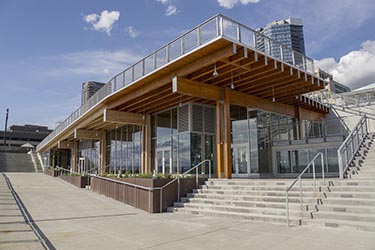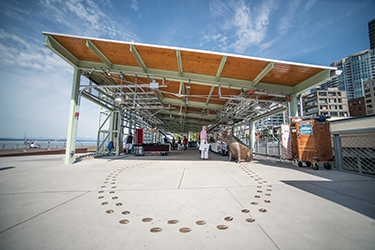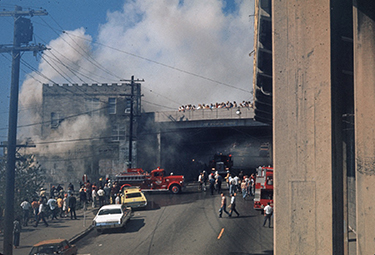|
Subscribe / Renew |
|
|
Contact Us |
|
| ► Subscribe to our Free Weekly Newsletter | |
| home | Welcome, sign in or click here to subscribe. | login |
Architecture & Engineering
| |
 |
June 29, 2017
MarketFront fulfills long-held dream to reclaim site marred by fire
Pike Place Market PDA

Franz
|
Pike Place Market today celebrates the grand opening of the brand new MarketFront — a historic expansion of the public market, decades in the making.
The expansion of the Market to the west fulfills the decades-long vision to reclaim the site along Western Avenue that was originally built in 1921 as the Municipal Market Building, and a space that was always intended for use by Market farmers and producers.
The MarketFront expansion — which was designed to align with Market historic district guidelines and the Pike Place Market charter — includes 30,000 square feet of open public space with expansive views of Puget Sound, room for 47 new farm and craft tables, 12,000 square feet of commercial space, 40 low-income housing units, 300 covered parking spaces and three public art installations. It is truly a “Market” expansion, a place where shoppers can “Meet the Producer,” as they have done since the Market was founded nearly 110 years ago.
To realize this long-held dream, the Pike Place Market Preservation and Development Authority (PDA), with help from its outstanding partners, had to overcome significant challenges, many of which prevented development on the site in the decades following the inclusion of the property in the Market Historic District in 1974.
Significant obstacles
After the Municipal Market Building was demolished after a fire in 1974, the 0.75-acre site was graded for surface parking. The site remained that way, with a wooden staircase leading up to the Desimone Bridge and into the Market’s North Arcade, until the groundbreaking of the MarketFront project in June 2015.
Over the years, at least eight different feasibility studies of the site were completed. Significant obstacles were identified such as the train tunnel beneath the site and restrictions on building heights. As a result, no development proposals were able to obtain adequate funding.
Sense of discovery
The opportunity to look again at the site on Western Avenue arrived with the city of Seattle’s plans to replace the Alaskan Way Viaduct and the greater central Seattle waterfront development. Parking mitigation dollars from the state and funding from the city made the plans for the site possible.
The community engaged in the planning for the new MarketFront, which was known at the time as PC-1, for “parking and commercial.” The process of design, development and financing for the project began in 2011 and followed a process committed to public engagement, with more than 200 public meetings held in the next four years.
Today, the MarketFront is the first completed piece of the waterfront’s larger redevelopment design, which will eventually connect Pike Place Market with the newly imagined waterfront park and busy Pike-Pine shopping corridor after the removal of the viaduct.
The Miller Hull Partnership designed the MarketFront, with inspiration taken from the sense of discovery Market-goers experience as they explore the many hidden alleys and winding passages of what many refer to as the “soul of Seattle.”
The design team looked to existing 20th-century industrial structures and simple materials, such as exposed timber beams, found throughout the Market. The building incorporates Northwest-style industrial toughness with large, open spaces that offer transparency inside and out.
Parking in and around downtown Seattle continues to be a challenge; this was taken into careful consideration for the MarketFront design. The MarketFront includes 300 new covered parking spaces that are open to the public every day, at below-market rates, as well as 33 parking spaces for bicycles.
Excavation and preliminary construction of the MarketFront began immediately after the June 2015 groundbreaking. Sellen Construction installed 120 drill piers and 22 grade beams around the BNSF Railway tunnel that runs beneath the MarketFront site, a very necessary step in protecting the tunnel.
Underground monitoring equipment was placed at the tunnel site to determine any shifting or movement in and around the site. These monitors were removed after one year.
Additionally, throughout early construction phases, cultural artifacts dating back to the turn of the 20th century were discovered. These discoveries created new challenges as archaeologists were brought in to analyze the significance and cultural background of these artifacts.
Narrowed down to the crew that built the BNSF train tunnel in the early 1900s, and a population of squatters, these artifacts present a unique look at Seattle’s history from the early days before Pike Place Market, and are now archived at the Burke Museum.
More than a market
The MarketFront’s upper level, adjacent to the Desimone Bridge, features a new plaza that provides panoramic views of Elliott Bay, as well as a pavilion that offers space for 47 new Market craftspeople and artists. On the lower level, the Producers Hall showcases on-site production for the Market’s newest food purveyors: Old Stove Brewing Co., Little Fish, indi chocolate and Honest Biscuits.
The MarketFront has three new public art installations — Northwest Microcosm, Western Tapestry and Billie the Piggy Bank — each designed by local artists.
Pike Place Market is more than a farmers market and tourist destination: It is literally home to some of Seattle’s most vulnerable, including low-income seniors. Through a U.S. Bank investment in low-income tax credits, the MarketFront project developed 40 new studio apartments for low-income seniors, several of whom were previously homeless.
At the new Market Commons, a neighborhood social services center, various programs will be offered to help meet the needs of the community through the Pike Place Market Foundation and other partnerships with organizations such as the Chief Seattle Club.
Thousands of donors
The Pike Place Market PDA led the $74 million MarketFront project with support from the city of Seattle, which contributed $34 million to the expansion; oversight from the Market Historical Commission; and input from the Market community.
The Pike Place Market Foundation launched its Pike Up! capital campaign, which helped to fund $6 million of the MarketFront expansion. More than 5,300 individuals, families, foundations and corporations donated to help bring the MarketFront vision to reality. Many of these donors have their names etched into Pike Place Market history with bronze hoof prints, ceramic fish and Market charms, all of which are displayed on the MarketFront plaza.
Ben Franz-Knight is the executive director of the Pike Place Market Preservation and Development Authority, a not-for-profit public corporation chartered by the city of Seattle in 1973 to manage the properties within the Market historic district.
Other Stories:
- Low-income housing joins the mix at MarketFront
- New open space is the next step on a path to the waterfront
- ‘This is going to be a wild ride’ for the design team
- MarketFront sits just inches above an active train tunnel: Here's how
- The story behind — and beneath — those big vent stacks





